|
|
|
In this Issue:
|
 |
| Workshop participants solar-bake bread in Ethiopia |
|
News you send
[Editor's note:
E-mail your news
items to
info@solarcookers.org or
via postal mail to Kevin Porter, Solar Cookers International, 1919 21st Street #101,
Sacramento, California 95811-6827, USA. We want to hear from you — especially if
your program is growing or if your work has not been featured in the Solar
Cooker Review before. Please include your contact information. Submissions are
subject to editing if printed.]
AFRICA
The Ethiopia / Netherlands
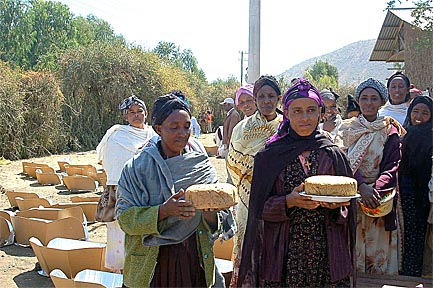 |
| Workshop participants successfully solar-bake bread in Ethiopia |
Initial pioneering work by Ato Guillilat, executive director of Partnership
for Integrated Sustainable Development Association, led in 2007 to a
small-scale integrated solar cooking pilot project with Solar Cooking
Foundation the Netherlands (SCN) in villages around Debre Zeit.
According to SCN Chairwoman Clara Thomas, initial results were promising. In
2008, plans were developed for a regional production and promotion center
for integrated solar cooking and water pasteurization. The center, which
opened in March 2009, includes space for training, assembly, sales, and
cooking demonstrations.
![Food continues to cook after a pot is removed from the heat source when placed in well-insulated retained heat devices, a component of the integrated solar cooking method]](../images/scr/nov09/PhotoL.jpg) |
| Food continues to cook after a pot
is removed from the heat source when placed in well-insulated retained
heat devices, a component of the integrated solar cooking method |
In the pilot project, approximately 1,500 households across four villages
have adopted integrated solar cooking methods, maximizing their cooking fuel
savings by using solar CooKits whenever possible, fuel-efficient stoves
(based on a design by GTZ) when necessary, and retained heat devices to
continue cooking after food is removed from either heat source.Janny Poley, first secretary for environment and water for the Royal
Netherlands Embassy in Addis Ababa, was impressed by the project and
introduced it to Horn of Africa Regional Environmental Centre and Network
(HOAREC/N) at Addis Ababa University. Under Poley’s leadership, HOAREC/N
held an integrated solar cooking workshop in March 2009 with participants
from Ethiopia, Sudan, Kenya, Somaliland, Puntland, Djibouti and the
Netherlands. Solar Cookers International’s Margaret Owino was among the key
speakers.
With technical support from SCN and KoZon Foundation, HOAREC/N will plan and
coordinate an ambitious 3-year program to spread integrated solar cooking
and solar water pasteurization in the region. Clusters will be created to
benefit three districts in Ethiopia and communities in Djibouti, Puntland,
and Somaliland. Clusters for people with physical and visual challenges, as
well as institutions, research and development agencies, and the health
sector, will be formed.Ultimately, each cluster will have a production and promotion center, a
project manager and a female master trainer. Field trainers will be selected
by master trainers, who will teach them promotion, monitoring, and
evaluation skills and help them lead monthly collective cooking meetings.
Contact: Clara Thomas or Arnold Leufkens, Solar Cooking Foundation the
Netherlands, Prof. van Reeslaan 11, 1261 CS Blaricum, Netherlands. Tel: +31
(0)35 5311903, fax: +31 (0)35 5318966, e-mail:
post@solarcooking.nl, Web:
solarcooking.nl; Horn of Africa Regional Environmental Centre and Network,
Web: http://hoarec.org
Ghana / United States
 It all started with a 20-minute cross-town taxi ride. Steven Watson, a
resident of New York City, and Frank Otchere, a resident of New Jersey (USA)
and Osiem, Ghana, met in early 2003 in Otchere’s taxi. Watson, a cultural
historian and psychologist, likes to learn from conversations with taxi
drivers. He also, as it happens, has an interest in solar cooking.
Otchere is the “Nkosuahene” of his village, the chief in charge of
development. In just a few short years, Watson and Otchere have organized
medicine contributions for Osiem, built the first public toilets, and
established what Watson calls “the best library in the region.” Now they are
working to bring simple solar cooking technology and know-how to the
community.
After initial failed attempts at building a solar cooker, Otchere went to
Washington D.C. to learn from Solar Household Energy. Louise Meyer and
Darwin Curtis gave him some pointers, and Otchere was then able to
successfully construct and use a solar CooKit in Ghana. He chose the CooKit
because it could be made inexpensively from aluminum foil and recycled
cardboard and required only a blackened cooking pot and a transparent
plastic bag.
Otchere repeatedly demonstrated the CooKit’s performance by preparing and
serving local foods — rice, plantains, yams, and palm nuts — to his
neighbors each day for lunch. The two questions he received most were “Will
I get sick if I eat this?” and “Is this magic?” Otchere responded “no” to
the former, and told them that food cooks by the “magic of the sun.”
It all started with a 20-minute cross-town taxi ride. Steven Watson, a
resident of New York City, and Frank Otchere, a resident of New Jersey (USA)
and Osiem, Ghana, met in early 2003 in Otchere’s taxi. Watson, a cultural
historian and psychologist, likes to learn from conversations with taxi
drivers. He also, as it happens, has an interest in solar cooking.
Otchere is the “Nkosuahene” of his village, the chief in charge of
development. In just a few short years, Watson and Otchere have organized
medicine contributions for Osiem, built the first public toilets, and
established what Watson calls “the best library in the region.” Now they are
working to bring simple solar cooking technology and know-how to the
community.
After initial failed attempts at building a solar cooker, Otchere went to
Washington D.C. to learn from Solar Household Energy. Louise Meyer and
Darwin Curtis gave him some pointers, and Otchere was then able to
successfully construct and use a solar CooKit in Ghana. He chose the CooKit
because it could be made inexpensively from aluminum foil and recycled
cardboard and required only a blackened cooking pot and a transparent
plastic bag.
Otchere repeatedly demonstrated the CooKit’s performance by preparing and
serving local foods — rice, plantains, yams, and palm nuts — to his
neighbors each day for lunch. The two questions he received most were “Will
I get sick if I eat this?” and “Is this magic?” Otchere responded “no” to
the former, and told them that food cooks by the “magic of the sun.”
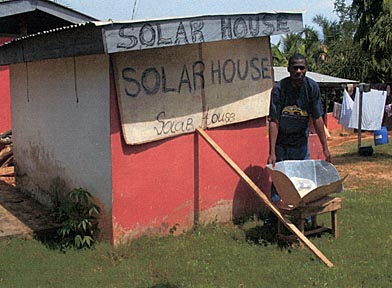 |
| Osiem's "Solar House" |
According to Watson, “the people in Osiem are convinced that solar cookers
work; they have seen it and they have eaten the food from CooKit.” Over 60
solar cookers have already been built by villagers, and are being sold for
about $5 each.
“Even though they understand that it will be economical and helpful over
time,” writes Watson, “it is still difficult for villagers to afford the
CooKit.” Otchere and Watson believe that solar cookers should not be given
away free of charge. They are exploring solutions to this problem. One
suggestion is to generate more local income by building CooKits in Osiem and
offer them for sale, along with training, in larger towns and cities like
Accra and Kofuridua. Another idea is to offer solar cookers in exchange for
work done in the local community.
Otchere has met with Dr. Mercy Bannerman, who has worked for several years
to reduce guinea worm infections and other waterborne pathogens in Ghana
through the use of solar water pasteurization (see the April 2005 Solar
Cooker Review article “Solar cookers: a tool for guinea worm prevention”).
Otchere and Bannerman agreed to cooperate in promotion of solar cooking in
Ghana — Bannerman focused in the Upper East, Upper West and Northern
regions; Otchere in the Eastern, Ashanti and Brong-Ahafo regions. Contact Steven Watson by e-mail:
stevenwatson@rcn.com
Nigeria
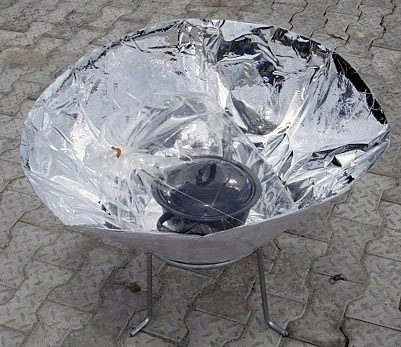 |
| Koshoni says cone-shaped solar cookers are well
suited for Nigerians with balconies |
Last year, Margaret Koshoni presented a solar cooking seminar in Lagos. The
seminar was arranged by the Cosmopolitan Women’s Club, of which Koshoni is
the secretary. A standing-room only crowd of nearly 400 representatives from
government agencies, nongovernmental organizations, women’s groups, schools,
and even a few banks, attended.
Prior to the event, Koshoni and her colleagues made over 1,000 solar CooKits
and “cone cookers.” Koshoni says that cone-shaped solar cookers are well
suited for many Nigerian women that have balconies because the cookers are
elevated on a stand above shadows created by balcony railings. The cookers
are also easy to move without disturbing the food.
Five cone cookers and three CooKits were used to demonstrate solar cooking
to the crowd. Beans, meat stews, fish stews, vegetable soup, yams, eggs, and
two types of rice were all prepared and sampled.
The cone cookers cost about $25 to construct using Mylar® reflector material
and water-resistant plastic sheet covering for the back. With financial
support from local banks and businesses, each school was given five cone
cookers and one CooKit free of charge, along with a copy of Solar Cookers
International’s plans booklet. Most of the other attendees received one
complimentary cone cooker, while solar CooKits were available for purchase
for about $15. Koshoni also made and distributed cloth bags for solar cooker
transport and storage.
The Lagos State Government’s Commissioner for Women Affairs encouraged
Koshoni to arrange future workshops for all Lagos State Local Government
Areas. Contact Margaret Koshoni by e-mail:
magkosh@gmail.com
ASIA AND OCEANIA
Japan
 Ogawa Crown Company has begun manufacturing small, portable parabolic solar
cookers that fold up in a similar fashion to an umbrella. The 1-meter
diameter reflective shell of the “Sunny Cooker” is made from a unique
aluminum-coated polyester cloth, structurally supported from the center and
along the outer edge by flexible plastic poles. This lightweight shell
essentially hangs from a metal pot stand that sits atop a foldable tripod
and is fixed to the shell at two points. The central pole of the tripod
connects to the pot stand through a zipper in the shell. The vertical angle
of the reflector is adjustable by zipping or unzipping the shell to the
appropriate distance and literally locking the zipper in place with a key.
The Sunny Cooker sells for approximately $350, weighs about 3.5 kilograms,
and comes with an iron kettle.
A sample of the Sunny Cooker was kindly provided to Solar Cookers
International by the Japan Solar Energy Educational Association. SCI Staff
and board members have experimented with the cooker and have successfully
boiled water and cooked popcorn. The device has been shown at multiple
events, including demonstrations at Google’s international headquarters in
Mountain View, California, and at National Defense University and the
Pentagon in Washington, DC. To order a Sunny Cooker at a discounted price, contact Iseko Shirai,
Japan Solar Energy Education Association, 2-42-30 Ogikubo, Suginami-ku, 167-0051
Tokyo, Japan. Tel/fax: 03-5347-1508, e-mail:
solar_energy@hyper.cx, Web:
http://solarcooker.blog10.fc2.com/blog-category-20.html.
For more information on the Sunny Cooker, visit:
http://ogawa-crown.co.jp/life_sport_sunnycooker.html (Japanese) or
http://ogawa-crown.co.jp/eng.pdf (English).
Ogawa Crown Company has begun manufacturing small, portable parabolic solar
cookers that fold up in a similar fashion to an umbrella. The 1-meter
diameter reflective shell of the “Sunny Cooker” is made from a unique
aluminum-coated polyester cloth, structurally supported from the center and
along the outer edge by flexible plastic poles. This lightweight shell
essentially hangs from a metal pot stand that sits atop a foldable tripod
and is fixed to the shell at two points. The central pole of the tripod
connects to the pot stand through a zipper in the shell. The vertical angle
of the reflector is adjustable by zipping or unzipping the shell to the
appropriate distance and literally locking the zipper in place with a key.
The Sunny Cooker sells for approximately $350, weighs about 3.5 kilograms,
and comes with an iron kettle.
A sample of the Sunny Cooker was kindly provided to Solar Cookers
International by the Japan Solar Energy Educational Association. SCI Staff
and board members have experimented with the cooker and have successfully
boiled water and cooked popcorn. The device has been shown at multiple
events, including demonstrations at Google’s international headquarters in
Mountain View, California, and at National Defense University and the
Pentagon in Washington, DC. To order a Sunny Cooker at a discounted price, contact Iseko Shirai,
Japan Solar Energy Education Association, 2-42-30 Ogikubo, Suginami-ku, 167-0051
Tokyo, Japan. Tel/fax: 03-5347-1508, e-mail:
solar_energy@hyper.cx, Web:
http://solarcooker.blog10.fc2.com/blog-category-20.html.
For more information on the Sunny Cooker, visit:
http://ogawa-crown.co.jp/life_sport_sunnycooker.html (Japanese) or
http://ogawa-crown.co.jp/eng.pdf (English).
NORTH AMERICA AND EUROPE
United
States
 |
| Goodman's solar cooker can be built in two pieces: a
weighted middle section that holds the HotPot and the four-sided
reflector that surrounds it |
Over the past several years, research architect Joel Goodman has
conceptualized a number of interesting ways to incorporate solar cookers
into buildings, outdoor furniture, and other public and private spaces. His
recent work has focused on reflector designs for use with Solar Household
Energy’s HotPot™ — a custom black metal pot suspended inside a transparent
glass bowl that creates an insulating air space around the pot.
 |
| Clockwise (from left): a raised cart with integrated
solar cooker and two additional reflectors; a series of three solar
cookers receive additional sunlight from a 'one-sided' CPC reflector
built into the side of a building and an additional reflector at one
end; an outdoor bench seat with built-in 'one sided' CPC reflector on
the reverse side for additional cooking power |
Goodman’s
latest idea consists of a modular solar cooker that could be used
independently or in conjunction with additional reflectors. The basic four-sided solar cooker uses principles of non-imaging CPC
(compound parabolic concentrator) optics to control the distribution of
light and maximize the amount of sunlight that hits the black surfaces under
the HotPot. A cross section of the cooker’s reflectors looks like a rounded
“w” with the cooking vessel resting on the middle hump at a height somewhat
lower than the end points. Goodman says the solar cooker could be built in
two parts, so that a weighted middle section holds the HotPot while the
surrounding reflectors could be removed and used at night to amplify indoor
lighting. For user comfort, Goodman suggests that a raised cart could be built to
house the basic reflector unit and support additional reflectors. Cooking
power also could be boosted by utilizing Goodman’s concept for ‘one-sided’
CPC reflectors that are part of exterior building walls or outdoor
furniture. He envisions one or more solar cookers pushed up against one of
these walls, which in turn direct additional sunlight onto the pot.
Goodman invites comments and suggestions. Contact: Joel H. Goodman, P.O. Box 14, Dodgeville, Wisconsin 53533, USA.
E-mail: joelhgoodman3@hotmail.com, Web:
http://solarcooking.org/Joel_Goodman.htm
and http://solarcooking.wikia.com/wiki/Joel_Goodman
Black carbon from cooking fires linked to global warming; solar cookers
offer immediate relief
by Kevin Porter, SCI director of education resources
“We see … women cooking meals over solar-powered stoves that produce less
black carbon and soot. We see the cutting down of pollution and respiratory
disease, and saving women from long trips to collect firewood, and save
diminishing forests.”
— U.S. Secretary of State Hillary Rodham Clinton

New research by leading atmospheric scientists indicates that black carbon
in soot — a byproduct of incomplete combustion — is responsible for an
estimated 18 percent of global warming, second only to carbon dioxide’s 40
percent. Studies show that anywhere from one-third to two-thirds of all
black carbon emissions come from the burning of biomass — including man-made
fires for industrial and household energy uses like cooking, as well as
naturally occurring forest fires. The remainder comes mostly from the
burning of fossil fuels such as diesel.
“Cleaner options for the man-made activities exist,” says Dr. Veerabhadran
Ramanathan, distinguished professor of Climate and Atmospheric Sciences at
the Scripps Institute of Oceanography in San Diego, California, USA, and
Jessica Seddon Wallack, director of the Center for Development Finance at
the Institute for Financial Management and Research in Chennai, India. “The
greenest options for households are stoves powered by the sun or by gas from
organic waste.”
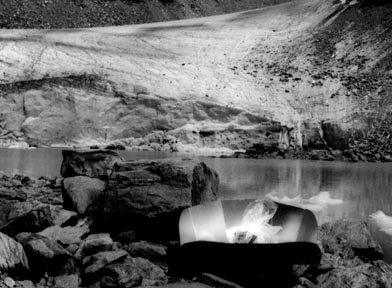 |
| Widespread use of clean, affordable solar cookers
(foreground) would help mitigate global warming and preserve glaciers
(background) |
Black carbon contributes to global warming by absorbing solar radiation.
Writing in the New York Times, reporter Elisabeth Rosenthal describes black
carbon as “tiny heat-absorbing black sweaters” that “melt ice by absorbing
the sun’s heat when they settle on glaciers.” Expanding upon this
description, Geoffrey Lean, environment editor for The Independent, explains
that black carbon “is spread around the globe by the wind, and helps to heat
the atmosphere by absorbing and releasing solar radiation. When it falls …
it darkens snow and ice, at the poles or high in mountains,” thus reducing
the ability of snow and ice to reflect sunlight. Snow and ice “melt more
quickly, and expose more dark land or water that absorbs even more energy …
and increases warming.”
Global warming isn’t the only problem caused by soot. Millions of people are
suffering debilitating, even deadly illnesses from black carbon exposure.
Andrew Revkin, reporter for the New York Times, states that the climate
impact from cooking with firewood and dried dung, “the norm for about 2
billion people … pales beside the direct impact on the lives of the people —
mainly women and their children — who spend a significant portion of the day
gathering the fuels or breathing the smoke.” According to the
nongovernmental organization Practical Action (formerly Intermediate
Technology Development Group), soot from indoor cook stoves is the
fourth-leading cause of premature death in the developing world.
Soot contains “up to 40 different cancer-causing chemicals, and can also
cause respiratory and heart diseases,” writes Lean. “It is estimated to
cause two million deaths in the developing world each year — mainly among
children — when emitted from wood-burning stoves in poorly ventilated
houses.”
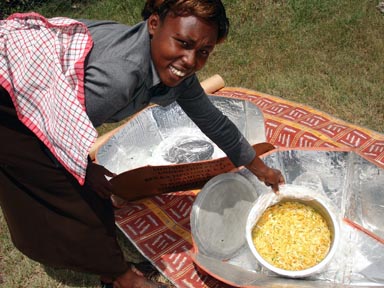 |
| Legislation under consideration in the U.S. Congress
seeks to bring soot-free cooking to 20 million families worldwide |
Researchers generally agree that reducing carbon dioxide emissions is the
most important long-term step in combating global warming. However,
widespread use of solar cookers and other soot-reducing technologies can
perhaps have the most immediate impact on the health of people and the
planet. “Reducing black carbon is one of a number of relatively quick and
simple climate fixes using existing technologies — often called ‘low hanging
fruit’ — that scientists say should be plucked immediately to avert the
worst projected consequences of global warming,” writes Rosenthal. “Better
still, decreasing soot could have a rapid effect. Unlike carbon dioxide,
which lingers in the atmosphere for years, soot stays there for a few
weeks.” Rosenthal continues, “In Asia and Africa, cook stoves produce the
bulk of black carbon. … Converting to low-soot cook stoves would remove the
warming effects of black carbon quickly, while shutting a coal plant takes
years to substantially reduce global carbon dioxide concentrations.”
Studies by Ramanathan show that “emissions from China and India alone
account for approximately 25 to 35 percent of global black carbon.” He
predicts that broad use of solar cookers and other soot-free stoves would
reduce black carbon’s heating effect on the earth by 70 to 80 percent over
South Asia, and 20 to 40 percent over East Asia.
The United States and many other developed nations have taken steps over the
years to greatly reduce domestic black carbon emissions through a variety of
regulations and access to cleaner-burning technologies. The U.S. Congress is
considering legislation to further mitigate the effects of black carbon
emissions in the U.S. and throughout the world. House bill 1760, the Black
Carbon Emissions Reduction Act of 2009, is currently being considered by
several committees. The bill would not only study ways to further limit
black carbon emissions in the U.S., but would also identify key regions of
the world for implementation of large-scale efforts to bring “clean,
efficient, safe, and affordable” cooking technologies like solar cookers “to
20 million homes over a 5-year period.”
Sunny Solutions surpasses goals, cookers now available through marketplace
by Kevin Porter, SCI director of education resources
 “I use solar energy to cook food and heat drinking water to [pasteurization]
temperatures. My charcoal, firewood and gas are saved for use when it is
dark or rainy. I can run an errand or do laundry while our meals cook.
Cooking beans and stews is easy now. I cough less and my eyes don’t water
like they used to. I bought my solar cooker from my cousin who received
special training so she could make money from selling CooKits.”
“I use solar energy to cook food and heat drinking water to [pasteurization]
temperatures. My charcoal, firewood and gas are saved for use when it is
dark or rainy. I can run an errand or do laundry while our meals cook.
Cooking beans and stews is easy now. I cough less and my eyes don’t water
like they used to. I bought my solar cooker from my cousin who received
special training so she could make money from selling CooKits.”
— Elizabeth, Sunny Solutions participant
In the summer of 2003, Solar Cookers International (SCI) launched an
ambitious project called
Sunny Solutions to increase market-based solar
cooker access in Nyakach, Kenya, an impoverished agricultural and fishing
community devastated by environmental degradation, waterborne illnesses, and
high incidence of HIV/AIDS. Over the next five years, more than 2,500 women
like Elizabeth purchased simple solar cookers and improved their lives with
free, clean solar energy. An independent project evaluation conducted in
June 2008 by Archway Technology Management Limited found widespread
awareness and use of solar cookers and solar water pasteurization in Nyakach,
resulting in a dramatic reduction of respiratory and waterborne diseases.
Goals and objectives
Over the years, SCI has implemented projects in several refugee camps where
solar cookers were distributed at little or no cost to beneficiaries. In
settled communities like Nyakach, however, long-term spread of solar cookers
typically requires commercial approaches. The goal of the Sunny Solutions
project was to create a viable market for solar cookers and related supplies
sold through small businesses run by local women.
The core objectives of the project were to:
- Introduce and spread solar cooking to 100,000 people
- Promote solar water pasteurization to 15,000 people
- Foster links with other common groups and agencies to ensure broad access
to solar cooking technology
- Enable commercialization of solar cooking supplies through support of
entrepreneurs selling 3,000 total CooKits
Implementation
SCI used a three-stage approach to solar cooker dissemination in Nyakach:
introduce solar cooking and water pasteurization to local opinion leaders,
recruit and train enthusiastic women as solar cooker representatives, and
assist these representatives in promotion of the CooKit, leading to
microenterprises that provide sales and after-sales services.
In partnership with the Nyakach Community Development Association (NYACODA),
SCI conducted solar cooking and water pasteurization demonstrations
targeting chiefs and other government officers, leaders of women’s groups,
health professionals and representatives of development agencies. Several
dozen solar CooKits were made available for home trials by a select group of
very keen women from each demonstration. These women were visited at home or
during weekly group meetings.
Women with outgoing personalities who used CooKits frequently, were
particularly enthusiastic about solar cooking, or had prior sales experience
were invited to train as solar cooker representatives (SCOREPS). Initial
training consisted of a four-day intensive course on solar cooking and
business skills, including microfinance, communications, and marketing,
followed by occasional sessions on more advanced topics.
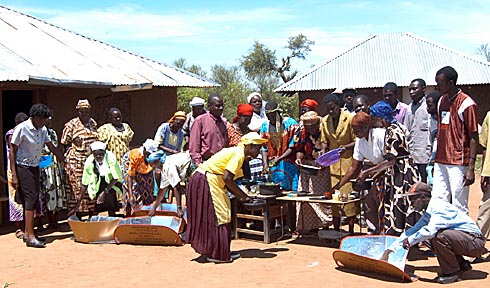 |
| SCOREPS conducted numerous trainings throughout
Nyakach, raising awareness of clean cooking technologies while earning
income from the sale of solar CooKits |
SCI partnered with the SCOREPS to develop marketing strategies appropriate
for local conditions. SCI provided basic marketing materials like flyers
explaining the economic and health benefits of solar cooker use, regional
newsletters featuring solar cooker promotion in eastern Africa, and
signboards for use at markets, along highways, etc. Distinctive aprons,
shirts and bags increased SCOREPS’ visibility and credibility. Direct
marketing was reinforced by SCI-sponsored public service announcements on
local radio programs.
Once trained, the entrepreneurial women conducted product demonstrations at
marketplaces, churches, and other public venues, creating widespread
awareness of — and desire for — solar cooking and solar water
pasteurization. SCOREPS were then able to generate income by making and
selling solar cookers, ensuring decentralized access to inexpensive solar
CooKits and related supplies.
To help guarantee broadest access to solar cookers, SCI worked with a total
of 247 churches, schools and women’s groups, some of which were formed to
purchase CooKits for each other in a merry-go-round fashion.
Each solar cooking kit, comprised of a solar CooKit, several transparent
cooking bags, and a Water Pasteurization Indicator (WAPI), sold for
approximately $6, resulting in a profit of about $1.25 for the
entrepreneurs. Additionally, SCOREPS earned commissions from SCI for certain
public demonstrations and up to three follow-up visits to each new solar
cook. These home visits provided an opportunity for SCOREPS to answer
questions, reinforce basic cooking skills, resupply cooking bags, and gather
feedback.
Innovations and awards
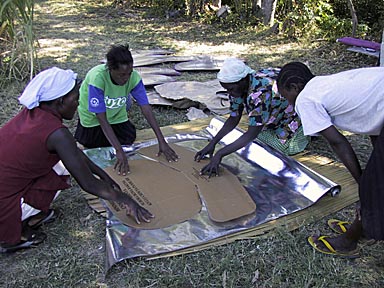 |
| The award winning OWYA CooKit, made locally SCOREPS,
increases income opportunities for women while lowering prices for
consumers |
The “OYWA” CooKit, developed and assembled for Sunny Solutions by Nyakach
women, is more affordable and more durable than factory-built models. The
OYWA, and the women that developed it, received a top award at the 2005
Pan-African Women Invent and Innovate awards ceremony. Organized by the
Global Women Inventors and Innovators Network, these awards are considered
the world’s leading accolade for women inventors and innovators.
In 2006, SCI was honored at the IX World Renewable Energy Congress for its
pioneering work promoting solar cookers in Africa. “You have been selected
for this award because of your dedication to promoting renewable energy in
Africa,” wrote Scott Haapala, award committee program officer, in notifying
SCI of the award. “Helping the people of Africa move away from a dependence
on firewood towards using renewable energy is helping to protect their
environment and increasing the quality of women’s lives.”
SCI’s eastern Africa director, Margaret Owino, received the first ever
International Net Forward Energy Award at the 3rd biennial Partnership for
Clean Indoor Air forum in 2007. The award honors those who improve peoples’
health, livelihood, and quality of life by reducing indoor air pollution.
SCI was also awarded the national 2007 Energy Globe award for its Sunny
Solutions project in Kenya. This prestigious award showcases sustainable
projects that demonstrate “good, feasible solutions” to existing
environmental problems.
Outcomes
The independent Sunny Solutions project evaluation concluded that all core
objectives were met.
Approximately 113,000 people (80 percent of the community) learned about
solar cooking through promotional campaigns and demonstrations, resulting in
sales of 3,154 solar CooKits to 2,593 households, each of which also
received a WAPI and safe water instruction. Eighty-eight households
purchased two or more CooKits.
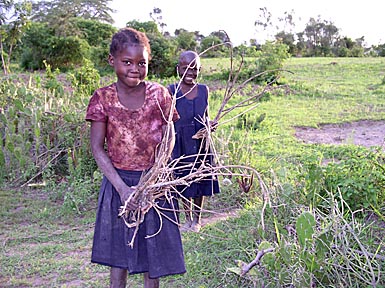 |
| In solar cooking households, less time is spent by
girls gathering firewood |
Of the households that purchased solar cookers, 85 percent reported using CooKits very often or often, while 11 percent used them rarely and 2 percent
never. A majority of those households, 53 percent, used CooKits for
pasteurizing water, while
cakes, vegetables, and meats were commonly
prepared with solar cookers in 79 percent, 42 percent and 34 percent of
households respectively. Solar cookers were rarely used to cook Ugali, a
local staple made from corn meal.
A fuel expenditure study of 12 households over a period of 15 days found
that non-solar cooking households spent an average of 8.35 Kenya shillings
per meal on cooking fuel (wood, charcoal and/or paraffin), while the
households that supplemented cooking fuels with solar cookers spent 4.45
Kenya shillings, a savings of 47 percent. Less time is spent by women and
children — especially girls — gathering firewood, leading to increased
productivity in farming, businesses, and schools.
Survey respondents were unanimous in citing health benefits from reduced
exposure to cooking smoke. These benefits included healthier throats, lungs,
and eyes reported by 70 to 85 percent of households. Furthermore, solar
water pasteurization has lowered incidence of waterborne diseases like
diarrhea by 78 percent.
SCOREPS developed greater self esteem and achieved increased status in their
families and community. Their spouses now treat them as partners in
household budgeting and decision making. SCOREPS were seen as role models
after presenting solar cooking information on local and national radio
programs. “The SCOREPS movement has proved itself as a formidable team
through which awareness creation and CooKit sales were achieved and can
continue beyond the project,” said evaluators. “There will, however, be the
need of support from the stakeholders and development partners, including
micro-lending institutions.”
Lessons learned
In retrospect, marketing might have been even more successful had SCI
consulted more widely with Kenyan-based social marketing experts in the
initial stages, started sales immediately rather than waiting until after an
initial awareness campaign, restricted activity to a smaller geographical
area (Nyakach is very spread out), used successful solar cooks as
spokespeople more frequently, and focused marketing messages on positive
economic and health benefits while more clearly explaining product
limitations.
Flexible payment plans and time frames are required when selling products to
severely impoverished people, even when long-term fuel savings will more
than make up for the cost of the CooKit. The layaway payment system that was
offered created unfortunate situations where customers had begun making
payments on cookers but did not actually receive them until they were paid
off, delaying the fuel savings that they so desperately needed to realize.
Factors that contributed to frequent use include:
- Understanding of the advantages of unattended cooking
- Presence of other solar cooks nearby
- Willingness to carry the CooKit with them to their workplace or farm
- Preference for the taste of solar-cooked foods
- Ease of heating household drinking water to kill pathogens
- Interest in maximizing firewood savings
Factors that contributed to infrequent use include:
- Not purchasing transparent cooking bags after the initial set wore out
- Absence from home during weekdays, combined with distrust of leaving food
cooking all day with no one present
- Fear of damage to the CooKit by unexpected rain, curious children or
wandering animals
- Discomfort with planning food purchases and food preparation in advance
- Poor results during an initial cooking session (too much water, started
too late, intermittent clouds coming in, etc.)
- Cannot be used at night or during inclement weather
- Multiple cookers needed for large families
- Cardboard not that durable
It is a challenge to develop and carry out a market-based solar cooker
initiative in a community with nearly 70 percent of the population living in
poverty. Over five years, SCI spent just under $325,000 planning, marketing,
implementing and evaluating Sunny Solutions. Many, many thanks to those who
are supporting this project and other SCI efforts in eastern Africa and
worldwide.
SCI ultimately achieved or exceeded most of its Sunny Solutions goals, and
now solar cookers are available through the local marketplace in Nyakach.
Building on these successes, SCI is expanding across Nyanza province.
Employees previously serving Nyakach have been redeployed to cover the whole
of Nyanza province from an office in the more centrally located town of
Kisumu. The town of Kakamega is the base for similar growth throughout
Kenya’s Western province, where SCI is working with 14 shopkeepers and small
businesses to stock solar cookers and supplies.
Contact: Marion Karewa Anyango, project assistant, Sunny Solutions Nyanza,
P.O. BOX 3766-40100, Kisumu, Kenya. Tel: + 254 721 833 704, e-mail:
marion_anyango@yahoo.com; Simon Omondi Ogutu, project officer, Sunny
Solutions Western, P.O. Box 2347 Code 50100, Kakamega, Kenya. Tel: +254 57
250 4876, e-mail: sunnywestern@yahoo.com
Message from the board president
 This year has brought Solar Cookers International (SCI) many changes, but
also reinforced its unique strengths and expanded volunteer efforts.
This year has brought Solar Cookers International (SCI) many changes, but
also reinforced its unique strengths and expanded volunteer efforts.
A search is underway for a new executive director following the recent
resignation of Patrick Widner. Former Executive Director Bev Blum is serving
in an interim capacity.
SCI, like many other nonprofit organizations, received fewer donations last
year. Support this year is rebounding, though, thanks to the exceptional
work of Resource Development Coordinator Rene Hamlin, Database Manager
Patricia Amazon, and you, our donors.
The world’s best source of information on solar cooking and solar water
pasteurization strategies, technologies, and key promoters continues to be
SCI’s Web sites. The recent, interactive wiki site is now updated by
promoters in 60 countries and can be searched by country, organization,
promoter, or type of solar cooker. Thanks to long-time volunteer webmaster
Tom Sponheim and Education Resources Director Kevin Porter for their ongoing
efforts to provide unparalleled content. SCI’s education resources
dissemination continues to grow thanks to Office Manager and Marketing
Coordinator Sierra Scott.
SCI’s six volunteer United Nations representatives now advocate for solar
cooking and solar water pasteurization systems with a much louder voice
thanks to the SCI-initiated Solar Cookers World Network of 100+ independent
organizations in 52 countries.
SCI’s Sunny Solutions microenterprise project in the western Kenya province
of Nyanza continues to spread to adjacent regions, including northern
Tanzania, thanks to Eastern Africa Director Margaret Owino and her dedicated
staff and local volunteers in each area. Grants from the Richard and Rhoda
Goldman Fund and U.S. Environmental Protection Agency have contributed to
this spread, and have helped SCI incorporate simple field tests for water
contamination, implemented by Dr. Bob Metcalf, a professor of biological
sciences and longtime SCI volunteer.
One thing that hasn’t changed this year is the ever-increasing need for
simple, affordable, sustainable solutions that reduce respiratory diseases
from smoke, diarrheal diseases from unsafe water, and women’s burdens from
firewood gathering. SCI continues to stretch every dollar of support by
utilizing numerous volunteers, including its excellent and devoted board of
directors.
Thanks again for helping to bring these solutions to more families. Your
donations make a world of difference.
Gary Hursh
SCI board president
Volunteer Don Coan inducted into SCI Order of
Excellence
by Kevin Porter, SCI director of education resources
 |
| Volunteer Don Coan tests solar cooking bags for
durability: 34 uses! |
Solar Cookers International (SCI) recently inducted volunteer Don Coan into
its Order of Excellence. He is the 10th person to earn this honor
recognizing those whose “sustained efforts have contributed most to
empowering people to cook food and pasteurize water with solar energy.”
Don has likely logged more volunteer hours than any other SCI office
volunteer. After retiring in 1988, Don found a meaningful way to spend some
of his free time when he discovered SCI, then called Solar Box Cookers
International. For more than two decades, Don has volunteered several hours
each week in our Sacramento office, often packaging solar cookers and
related products for distribution.
In the early days, Don helped to disseminate thousands of simple
instructions for building solar box cookers. He also led numerous solar
cooker construction workshops, and represented SCI in a Sacramento Municipal
Utility District school program. To this day, Don is approached by adults
who, as children, made solar box cookers with him.
Don is a tireless advocate of solar cooking. He has participated in a number
of international conferences and events, has hosted multiple solar cooking
booths at the California State Fair, and has written letters to and been
interviewed by the media. Don even taught his neighbors how to solar cook,
and organized annual neighborhood solar cooking picnics.
We are blessed to see Don each week, and benefit greatly from his
steadfastness and enthusiasm for our mission. Not only is he one in a
million, but he can solar bake a mean dessert to boot. But that’s just icing
on the cake!
Jean Runyon remembered as SCI supporter, advocate

Solar Cookers International staff and board members are saddened by the
passing of Jean Runyon. Jean not only gave generously to SCI over the years,
but she also hosted a wonderful brunch at her home to which she invited
people whom she thought might be interested in SCI’s programs. As a result
of this gathering, more than $50,000 was raised by a single invitee in the
months to follow. This is just one example of Jean’s good works and how her
championship of causes has made such a difference to many. We wish her
family well.
Youth giving, solar style
by Rene Hamlin, SCI resource development coordinator, and Kevin Porter, SCI
director of education resources
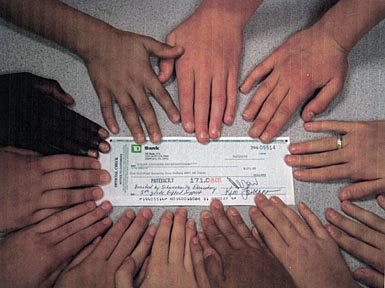 |
| Youth proudly and passionately support solar cooking
efforts by raising awareness and funds, as did these students from
Schwenksville Elementary School |
Many, if not a majority, of Solar Cookers International’s supporters are
middle-aged or older, and have some discretionary income. However, we see
great potential in today’s youth, specifically those under 25, and are
brainstorming ways to engage them further and encourage their support — both
through volunteerism and giving.
We are continually amazed at the ingenuity and spirit we have seen from many
in this age group. They are organizing fundraisers, such as benefit concerts
and solar bake sales, as well as giving a portion of their allowance or
paychecks. Most of these events happen without our prior knowledge. We
typically receive a check in the mail, along with a nice letter and a
photograph or two, which we take great delight in reading.
Here are some inspiring recent examples:
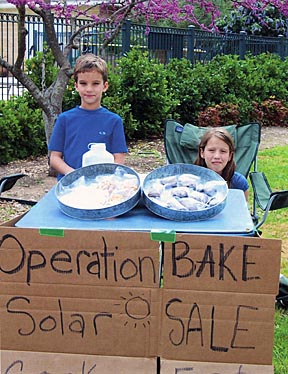 |
| Operation Solar Bake Sale |
Claire and Charlie, from Texas, held “Operation Solar Bake Sale” to raise
funds for Solar Cookers International (SCI). “I think this is a great idea.
I was happy to help!” said Claire.
- Tracy Moreno, from Schwenksville Elementary School in Schwenksville,
Pennsylvania, wrote to say that her talented 5th graders designed and built
solar cookers and used them to cook mini s’mores for classmates. Moreno
utilized SCI’s Web site and materials to teach the children about the plight
of women around the world that don’t have access to clean cooking fuels.
“Facilitating the learning of young people by integrating engaging lessons
with global issues is truly a love of mine,” writes Moreno. “I thank you for
the resources that provided me the opportunity to inspire these terrific
children.” The students held a fundraiser and collected over $150 for SCI’s
programs.
- Nissa, a high school senior from New York, is not only raising funds for
SCI, but also for her own solar cooker project in Nepal next year. Nissa
held a benefit concert called “Solar Songs” featuring a number of local and
national musicians, raising funds through business sponsorships and
donations by concertgoers. Nissa is “passionate about environmental issues
and global citizenship” and says that a solar cooker project “seemed like a
perfect way to combine the two.”
- Cary Williams reports that 5th graders from Winnetka, Illinois, studied
solar energy applications and African cultures and languages, and then
combined the two by exploring ways solar energy could be used to benefit
those in sunny parts of Africa who struggle to cook food and pasteurize
drinking water on a daily basis. Some students made solar ovens, others
designed solar water purifiers. One student even created a backpack solar
cooker that could be worn while walking. Towards the end of the year, the
youth researched nonprofit organizations that specialize in solar cookers.
SCI was the “winner” and the students raised funds for us by selling “Sun
Shine Shakes” to students for $2 each. They ultimately raised over $600 for
SCI to “send to Africa as many solar cookers as possible.” Says Williams,
“This has been a learning and growing year. None of us will forget the power
of the sun and the good that can be done all over the word when we harness
it.”
Not all the youth gifts come from grassroots efforts. Models of traditional
and non traditional giving exist that are youth-driven and focused.
Nonprofit organizations like Markmakers Foundation (markmakers.org) and the
One Percent Foundation (onepercentfoundation.org) educate youth about
evaluating and supporting organizations. SCI is a giving option for youth
who are using the Markmakers shopping cart-style Web site. SCI has recently
been nominated as a grant recipient in the more traditional One Percent
Foundation method of giving as well.
Whether through grassroots efforts or formal mechanisms, youth are giving
and they are supporting SCI’s mission of promoting solar cooking and solar
water pasteurization systems for the benefit of people and environments. We
are honored and inspired by their support and we thank them for being so
selfless. If you have thoughts on ways to increase youth involvement, or
would like more information about supporting SCI, please contact SCI
Resource Development Coordinator Rene Hamlin at (916) 455-4499 or
rene@solarcookers.org.
Solar Cookers World Network update
by Bev Blum, SCWNet secretariat
Future Goals
The nine partner agencies that comprise the Steering Committee of the Solar
Cooker World Network (SCWNet) have proposed goals for the next three years
that would include advocacy support, improved standards for solar cookers
and related technologies, and strategies for up-sizing small successes.
SCWNet hopes to begin raising funds for these and more activities.
Specific activities for 2010-2012 include:
- Sustained cultivation of governments, international nongovernmental
organizations, and the United Nations (U.N.) in support of members’
projects. Examples include advocacy efforts at the World Health
Organization, the U.N. High Commissioner for Refugees, the Commission on
Sustainable Development, and the U.S. government’s Partnership for Clean
Indoor Air.
- Sharing tools and opportunities, including educational literature, case
studies of well-documented projects, and grant opportunities.
- Revision and expansion of standards for solar cooker capacity,
convenience, cost, durability, versatility, and target markets.
- Compiling a list of the most widely-used solar cookers worldwide.
Partner opportunity
Solar Electric Light Fund (SELF) has installed solar photovoltaic (PV)
panels in rural villages in Africa, Asia, the Caribbean, and on Native
American reservations for 19 years. While SELF’s expertise is in solar PV,
it has begun to partner with organizations to introduce wells, drip
irrigation and other “green” technologies into its projects. Bob Freling,
SELF’s executive director, recently took a solar Hot Pot to Benin for
testing.
Freling notes that solar PV installations are not able to generate enough
electricity for cooking. Thus, women in these electrified villages still
have to chop down trees or collect dung for their cooking fires. He is
interested in exploring partnerships with solar cooking organizations
working in villages where SELF is already established. (He is not offering
funding.)
Contact: Bev Blum, secretariat, Solar Cookers World Network, e-mail:
scwnet@solarcooking.org, Web: solarcooking.org/scwnet; Bob Freling,
executive director, Solar Electric Light Fund, 1612 K Street, NW Suite 402,
Washington, DC 20006, USA. E-mail: info@self.org, Web: self.org.
Alternative giving this holiday season
by Sierra Scott, Office Manager and Marketing Coordinator
 The holidays are fast approaching. As in years past, Solar Cookers
International (SCI) wishes to encourage its members and supporters to
consider alternative gift-giving, the practice of making a meaningful
contribution to a worthy cause in lieu of a traditional present. There are
many great reasons to engage in this form of giving, including: promoting
altruism, mitigating the effects of the holidays on the environment, and
emphasizing the true spirit of the season.
The holidays are fast approaching. As in years past, Solar Cookers
International (SCI) wishes to encourage its members and supporters to
consider alternative gift-giving, the practice of making a meaningful
contribution to a worthy cause in lieu of a traditional present. There are
many great reasons to engage in this form of giving, including: promoting
altruism, mitigating the effects of the holidays on the environment, and
emphasizing the true spirit of the season.
A popular way of participating in alternative giving is to make a donation
in someone else’s name. For this we offer gift cards personalized with a
hand-written message of your choosing. And for those who prefer to buy
something that can be unwrapped, there’s good news — the proceeds from sales
of our solar cooking products support our nonprofit work, and the gift
recipients are introduced to the wonderful benefits of cooking with the sun!
To place your holiday orders, please visit the SCI Marketplace at
http://www.solarcookers.org/catalog or contact SCI Office Manager and Marketing
Coordinator Sierra Scott at +1 (916) 455-4499.
Tributes
Tribute gifts have been given to Solar Cookers International by:
- Joyce Cassel in memory of Prof. John Pollock
- Therese Edlin in honor of David Toma
- Karyn Ellis in honor of Carolyn J. Ellis
- Prissy Lee in memory of Vivian Moore Lee
- Werner and Helen Muller in honor of Louisa Fanver
- Claire Russell in honor of Bel Aire School
- George Smith in memory of Jo Smith
- Gwynne and Dewey Smith in memory of George and Gertrude Prosser
- Dorothy Stewart in honor of the marriage of William Sherman and Jane
Snellman
SCI financial summary July 2008 – June 2009
Revenues
- Donations - $604,967
- Grants - $128,889
- Sales (gross profit) - $114,415
- Donated goods and services - $17,173
- Other - ($151)
TOTAL - $865,293
Expenses
- International programs - $431,038
- Education resources - $178,686
- Advocacy - $59,812
- Humanitarian assistance - $25,096
- Resource development - $104,117
- Administration - $101,648
TOTAL - $900,397
Assets
- Cash - $195,160
- Investments - $38,817
- Grants receivable - $109,105
- Equipment and vehicles - $14,104
- Inventories for sale - $13,615
- Other - $8,809
TOTAL - $379,610
Liabilities
TOTAL - $23,814
NET ASSETS (06/30/09) - $355,796
Calling all U.S. federal employees!
 Are
you a federal employee? Do you know one? Solar Cookers International (SCI) has
again qualified as a participating organization in the Combined Federal Campaign
(CFC). SCI is a beneficiary of the effort through the Aid for Africa Federation.
We are proud to meet the rigorous financial, accountability, and governance
standards, and ask for your CFC support.
Are
you a federal employee? Do you know one? Solar Cookers International (SCI) has
again qualified as a participating organization in the Combined Federal Campaign
(CFC). SCI is a beneficiary of the effort through the Aid for Africa Federation.
We are proud to meet the rigorous financial, accountability, and governance
standards, and ask for your CFC support.
Federal employees have the option of supporting SCI with either a one-time
gift or with recurring payroll deductions. For those interested in joining
the effort, our CFC number is 11023. This code directs your donation to
SCI’s Africa programs. Information is available on-line at
http://aidforafrica.org/members.php?id=43.
Your questions are also welcomed by SCI Resource Development Coordinator
Rene Hamlin. You can reach her by telephone: +1 (916) 455-4499, or e-mail:
rene@solarcookers.org
Thanks, federal employees, for your philanthropy and involvement in the
effort to spread this sustainable solar solution.
Solar Cooker Review
Solar Cooker Review (“Review”) is published two or three times per year with the
purpose of presenting solar cooking and solar water pasteurization information
from around the world. Topics include solar cooker technologies, dissemination
strategies, educational materials, and cultural and social adaptations. From
time to time we cover related topics such as women’s issues, wood shortages,
health, nutrition, air pollution, climatic changes, and the environment.
The Review is sent to those who contribute money or news about solar cooking
projects. The suggested subscription price is $10/year. Single copies are
sent free to select libraries and groups overseas.
We welcome reports and commentary related to solar cooking for possible
inclusion. These may be edited for clarity or space. Please cite sources
whenever possible. Send to Solar Cookers International (SCI), 1919 21st
Street #101, Sacramento, California 95811-6827, USA. You may also submit by
fax: +1 (916) 455-4498 or e-mail:
kevin@solarcookers.org.
The Review is compiled and edited by Kevin Porter, SCI’s director of
education resources, with assistance from other staff. Layout is graciously
donated by IMPACT Publications located in Medford, Oregon, USA.
SCI is a 501(C)(3) nonprofit organization assisting communities in using the
power of the sun to cook food and pasteurize water for the benefit of people
and environments. SCI is a member of InterAction. We do not sell, rent or
trade names of donors. Tax ID # 68-0153141.
The Review is available on-line at
http://solarcooking.wikia.com/scr


![Food continues to cook after a pot is removed from the heat source when placed in well-insulated retained heat devices, a component of the integrated solar cooking method]](../images/scr/nov09/PhotoL.jpg)
 It all started with a 20-minute cross-town taxi ride. Steven Watson, a
resident of New York City, and Frank Otchere, a resident of New Jersey (USA)
and Osiem, Ghana, met in early 2003 in Otchere’s taxi. Watson, a cultural
historian and psychologist, likes to learn from conversations with taxi
drivers. He also, as it happens, has an interest in solar cooking.
Otchere is the “Nkosuahene” of his village, the chief in charge of
development. In just a few short years, Watson and Otchere have organized
medicine contributions for Osiem, built the first public toilets, and
established what Watson calls “the best library in the region.” Now they are
working to bring simple solar cooking technology and know-how to the
community.
After initial failed attempts at building a solar cooker, Otchere went to
Washington D.C. to learn from Solar Household Energy. Louise Meyer and
Darwin Curtis gave him some pointers, and Otchere was then able to
successfully construct and use a solar CooKit in Ghana. He chose the CooKit
because it could be made inexpensively from aluminum foil and recycled
cardboard and required only a blackened cooking pot and a transparent
plastic bag.
Otchere repeatedly demonstrated the CooKit’s performance by preparing and
serving local foods — rice, plantains, yams, and palm nuts — to his
neighbors each day for lunch. The two questions he received most were “Will
I get sick if I eat this?” and “Is this magic?” Otchere responded “no” to
the former, and told them that food cooks by the “magic of the sun.”
It all started with a 20-minute cross-town taxi ride. Steven Watson, a
resident of New York City, and Frank Otchere, a resident of New Jersey (USA)
and Osiem, Ghana, met in early 2003 in Otchere’s taxi. Watson, a cultural
historian and psychologist, likes to learn from conversations with taxi
drivers. He also, as it happens, has an interest in solar cooking.
Otchere is the “Nkosuahene” of his village, the chief in charge of
development. In just a few short years, Watson and Otchere have organized
medicine contributions for Osiem, built the first public toilets, and
established what Watson calls “the best library in the region.” Now they are
working to bring simple solar cooking technology and know-how to the
community.
After initial failed attempts at building a solar cooker, Otchere went to
Washington D.C. to learn from Solar Household Energy. Louise Meyer and
Darwin Curtis gave him some pointers, and Otchere was then able to
successfully construct and use a solar CooKit in Ghana. He chose the CooKit
because it could be made inexpensively from aluminum foil and recycled
cardboard and required only a blackened cooking pot and a transparent
plastic bag.
Otchere repeatedly demonstrated the CooKit’s performance by preparing and
serving local foods — rice, plantains, yams, and palm nuts — to his
neighbors each day for lunch. The two questions he received most were “Will
I get sick if I eat this?” and “Is this magic?” Otchere responded “no” to
the former, and told them that food cooks by the “magic of the sun.”

 Ogawa Crown Company has begun manufacturing small, portable parabolic solar
cookers that fold up in a similar fashion to an umbrella. The 1-meter
diameter reflective shell of the “Sunny Cooker” is made from a unique
aluminum-coated polyester cloth, structurally supported from the center and
along the outer edge by flexible plastic poles. This lightweight shell
essentially hangs from a metal pot stand that sits atop a foldable tripod
and is fixed to the shell at two points. The central pole of the tripod
connects to the pot stand through a zipper in the shell. The vertical angle
of the reflector is adjustable by zipping or unzipping the shell to the
appropriate distance and literally locking the zipper in place with a key.
The Sunny Cooker sells for approximately $350, weighs about 3.5 kilograms,
and comes with an iron kettle.
A sample of the Sunny Cooker was kindly provided to Solar Cookers
International by the Japan Solar Energy Educational Association. SCI Staff
and board members have experimented with the cooker and have successfully
boiled water and cooked popcorn. The device has been shown at multiple
events, including demonstrations at Google’s international headquarters in
Mountain View, California, and at National Defense University and the
Pentagon in Washington, DC. To order a Sunny Cooker at a discounted price, contact Iseko Shirai,
Japan Solar Energy Education Association, 2-42-30 Ogikubo, Suginami-ku, 167-0051
Tokyo, Japan. Tel/fax: 03-5347-1508, e-mail:
solar_energy@hyper.cx, Web:
http://solarcooker.blog10.fc2.com/blog-category-20.html.
For more information on the Sunny Cooker, visit:
http://ogawa-crown.co.jp/life_sport_sunnycooker.html (Japanese) or
http://ogawa-crown.co.jp/eng.pdf (English).
Ogawa Crown Company has begun manufacturing small, portable parabolic solar
cookers that fold up in a similar fashion to an umbrella. The 1-meter
diameter reflective shell of the “Sunny Cooker” is made from a unique
aluminum-coated polyester cloth, structurally supported from the center and
along the outer edge by flexible plastic poles. This lightweight shell
essentially hangs from a metal pot stand that sits atop a foldable tripod
and is fixed to the shell at two points. The central pole of the tripod
connects to the pot stand through a zipper in the shell. The vertical angle
of the reflector is adjustable by zipping or unzipping the shell to the
appropriate distance and literally locking the zipper in place with a key.
The Sunny Cooker sells for approximately $350, weighs about 3.5 kilograms,
and comes with an iron kettle.
A sample of the Sunny Cooker was kindly provided to Solar Cookers
International by the Japan Solar Energy Educational Association. SCI Staff
and board members have experimented with the cooker and have successfully
boiled water and cooked popcorn. The device has been shown at multiple
events, including demonstrations at Google’s international headquarters in
Mountain View, California, and at National Defense University and the
Pentagon in Washington, DC. To order a Sunny Cooker at a discounted price, contact Iseko Shirai,
Japan Solar Energy Education Association, 2-42-30 Ogikubo, Suginami-ku, 167-0051
Tokyo, Japan. Tel/fax: 03-5347-1508, e-mail:
solar_energy@hyper.cx, Web:
http://solarcooker.blog10.fc2.com/blog-category-20.html.
For more information on the Sunny Cooker, visit:
http://ogawa-crown.co.jp/life_sport_sunnycooker.html (Japanese) or
http://ogawa-crown.co.jp/eng.pdf (English).




 “I use solar energy to cook food and heat drinking water to [pasteurization]
temperatures. My charcoal, firewood and gas are saved for use when it is
dark or rainy. I can run an errand or do laundry while our meals cook.
Cooking beans and stews is easy now. I cough less and my eyes don’t water
like they used to. I bought my solar cooker from my cousin who received
special training so she could make money from selling CooKits.”
“I use solar energy to cook food and heat drinking water to [pasteurization]
temperatures. My charcoal, firewood and gas are saved for use when it is
dark or rainy. I can run an errand or do laundry while our meals cook.
Cooking beans and stews is easy now. I cough less and my eyes don’t water
like they used to. I bought my solar cooker from my cousin who received
special training so she could make money from selling CooKits.”


 This year has brought Solar Cookers International (SCI) many changes, but
also reinforced its unique strengths and expanded volunteer efforts.
This year has brought Solar Cookers International (SCI) many changes, but
also reinforced its unique strengths and expanded volunteer efforts.



 The holidays are fast approaching. As in years past, Solar Cookers
International (SCI) wishes to encourage its members and supporters to
consider alternative gift-giving, the practice of making a meaningful
contribution to a worthy cause in lieu of a traditional present. There are
many great reasons to engage in this form of giving, including: promoting
altruism, mitigating the effects of the holidays on the environment, and
emphasizing the true spirit of the season.
The holidays are fast approaching. As in years past, Solar Cookers
International (SCI) wishes to encourage its members and supporters to
consider alternative gift-giving, the practice of making a meaningful
contribution to a worthy cause in lieu of a traditional present. There are
many great reasons to engage in this form of giving, including: promoting
altruism, mitigating the effects of the holidays on the environment, and
emphasizing the true spirit of the season. Are
you a federal employee? Do you know one? Solar Cookers International (SCI) has
again qualified as a participating organization in the Combined Federal Campaign
(CFC). SCI is a beneficiary of the effort through the Aid for Africa Federation.
We are proud to meet the rigorous financial, accountability, and governance
standards, and ask for your CFC support.
Are
you a federal employee? Do you know one? Solar Cookers International (SCI) has
again qualified as a participating organization in the Combined Federal Campaign
(CFC). SCI is a beneficiary of the effort through the Aid for Africa Federation.
We are proud to meet the rigorous financial, accountability, and governance
standards, and ask for your CFC support. 